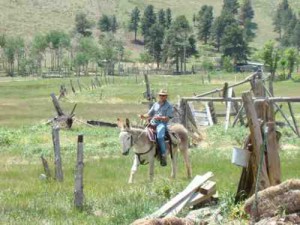Review by Martha Quillen
Fiction – January 2009 – Colorado Central Magazine
Hard Face Moon
by Nancy Oswald
Published in 2008 by Filter Press
ISBN-13: 978-0-86541-089-3
NOTHING HERE BUT STONES, Nancy Oswald’s first historical novel, was an impressively researched tale written for young people, which illuminated the disappointments and hardships faced by a group of Jewish refugees who settled in Cotopaxi for a short time.
The group’s sponsors paid good money upfront to provide their countrymen with finished cabins on arable land where they could create a new life. But instead of finding Eden, the community ended up living on a rocky mountainside with a perilously short growing season where they huddled in drafty shacks furnished with blankets rather than doors, while outside the wind howled, the snow piled up, and a bear marauded.
Oswald’s first historical book told a captivating local tale with elan, and I recommend it.
But I figured Hard Face Moon would be a much trickier tale to tell. Oswald’s first book fleshed out a seldom-told piece of history, whereas Hard Face Moon is about one of America’s most definitive and infamous events: the massacre of Cheyenne and Arapaho people camped at Sand Creek by a Colorado territorial regiment led by Colonel John M. Chivington.
I couldn’t figure out how an author could make such a story fitting for young people, especially since the soldiers carried off “souvenirs” — made from scalps, genitals, and body parts — to put on display in Denver.
But I was impressed with Oswald’s book. If anything, Hard Face Moon has a bit more heart than the author’s first novel, which is a fascinating tale, but lacks a central protagonist.
In Hard Face Moon, the main character, Hides Inside, is an angry, frustrated thirteen-year-old who has been mute since seeing his mother kidnapped by the Pawnee when he was a toddler. Hides Inside is trying desperately to become a great hunter and warrior despite his obvious disability, understandable doubts on the part of his elders, and cruel taunts by one of his cohorts.
This is a classic kid’s tale about bullying, injustice, and resentment which pulls the reader in so thoroughly, that you almost forget what’s coming.
But even young people unfamiliar with Colorado history will realize what’s coming. Violent encounters between native Americans and the white population were growing more common in 1864, and Oswald accurately portrays her Cheyenne characters at Sand Creek as constantly arguing about whether to embrace war or peace.
It doesn’t take an historian to see that disaster is awaiting Black Kettle’s band.
Oswald handles the climax well, and without undue gore. The boys hear the screams and gunfire and see women and children mowed down, but their concentration is on getting out of there and finding a place to hide.
In the end, the boys become men, not by being great hunters, or archers, or warriors — as they have always dreamed they would — but by the simple act of helping their brethren seek shelter. It’s a moral worthy of a great children’s book — and a wonderful Christmas gift.
But I think the finest aspect of Hard Face Moon is what it avoids.
Years ago Ed and I saw Annette Jaimes, Indian activist and ex-wife of well-known activist Ward Churchhill, speak at Western State College. Someone asked Jaimes what she thought about Dances With Wolves, a popular and much praised film at the time, and she said she didn’t think white people should be allowed to write about Indians. When someone tried to point out how unfair he thought that was, she ranted about the unfairness of genocide, lies, land-stealing, etc. and announced that all white men should go home.
Clearly, Jaimes was a mite overzealous. But such zeal was effective.
The rampant emotionalism of the much needed civil liberties movement focusing on modern inequities faced by Native Americans, however, gave way to a political correctness that tended to characterize Native Americans as wholly noble, victimized, downtrodden, abused, long-suffering, environmentally aware, and prone to talking in poetic homilies and cliches. And that, I think, is as untrue and offensive as characterizing Native Americans as heathens and savages. Such stereotypes obliterate history and sense by squeezing individuals, bands, tribes and nations into one caricature of an Indian, which is a bit like fusing Washington, Napoleon and Hitler into one great white chief.
Oswald’s book is a fictionalized account of Sand Creek from the viewpoint of the Cheyenne told by an Anglo, and there are all sorts of cultural and political problems possible in such an account.
But the mistake, I think, would be if authors quit trying to see events from the viewpoint of past enemies.
Oswald acquits herself well by thoroughly researching her subject and creating a village of fully fleshed humans rather than just winners or losers.
And in the end, the real and absolute truth is that not one of us will ever really know what it was like to be at Sand Creek 144 years ago — not Jaimes, not myself, and not Oswald. But we can imagine and commemorate it, and Oswald does that well.


